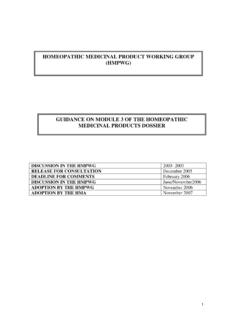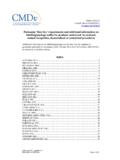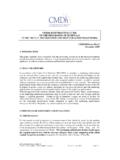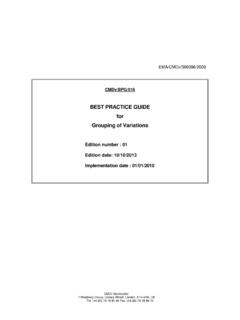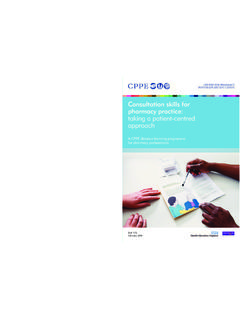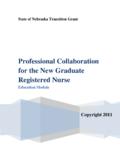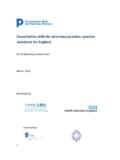Transcription of CONSULTATION WITH TARGET PATIENT GROUPS …
1 CONSULTATION with TARGET PATIENT GROUPS - MEETING THE REQUIREMENTS OF ARTICLE 59(3) WITHOUT THE NEED FOR A FULL TEST - RECOMMENDATIONS FOR BRIDGING October 2007 1. INTRODUCTION Guidance has already been issued from the CMD(h) which indicates that although all package leaflets (PLs) for medicines must reflect the results of CONSULTATION with TARGET PATIENT GROUPS (user testing) and include within the marketing authorisation, data in module m-1-3-4- of the eCTD, not every leaflet needs be the subject of a separate test. PLs may be able to rely on testing applied to PLs for similar products. The guidance is available from: #irfaq_31_14 guidance is available from the European Commission in the guideline on the readability of the labelling and on the package leaflet.
2 A link to the draft guidance is attached: This document provides guidance on when bridging will be accepted by competent authorities and the type of evidence which will need to be provided in support of applications where data in line with the requirements of article 59(3) of Council Directive 2001/83/EC are required. Even though some examples are provided within this document this is not exhaustive and each case will be judged on its merits. 2. SCOPE The guidance is applicable to all applications for marketing authorisations held by one company where a user test (or other evidence of compliance with article 59(3)) is required. It will apply to applications for new marketing authorisations, significant variations to MAs, renewal applications and applications where harmonisation of the PL is undertaken and which must be accompanied by data demonstrating compliance with article 59(3).
3 3. DEFINITIONS Minor changes to content or layout of a document can impact adversely on the readability. These differences can affect whether or not the resultant PL is clear, legible and easy to use as required by law. The term bridging has been described to apply to leaflets which are sufficiently similar in both content and layout. CONSULTATION with TARGET PATIENT GROUPS Recommendations for bridging October 2007 Page 1/6 In bridging, a successful user test on one PL [the parent PL] can be used to support a justification for not testing other similar leaflets [ daughter PLs]. In some circumstances it may be appropriate for some daughter PLs to rely on the results of testing for more than one parent PL.
4 Since the design and layout of the information is crucial to how the information is used and understood, daughter PLs should be of the same design, layout and writing style as the parent PL in order for bridging to be successful. A bridging proposal is unlikely to be acceptable to the competent authority where this concept has not been adhered to. 4. KEY MESSAGES FOR SAFE USE A successful user test will have identified up-front the key messages for safe use with the particular medicine in question. For each medicine these messages will be different although the leaflet will cover the same sort of information in the same manner. The questionnaire within the protocol will have to address these key messages and provide evidence that these messages can be found and understood so that the medicine can be used safely.
5 Such a user test could then be relied upon to support a PL drawn up in the same manner for a closely related medicine. In a bridging study the key messages for safe use for both the parent and daughter PLs need not be identical. However, high profile safety issues should be included in the key points tested for each daughter PL. 5. FORMAT, DESIGN AND LAYOUT AND WORDING OF THE PL The design and layout of the information in the PL is crucial to the way in which patients access the key messages for safe use. Most marketing authorisation holders have a recognisable house style in this regard. In order for bridging to be successful both the parent and daughter PLs should have a common design, layout and style of writing.
6 The following important aspects should be considered: Font and font size Headings and sub-headings including consistency of placement PL dimensions including whether the document is laid out in portrait or landscape format Use of colour and choice of colour Style of writing and language used Layout of critical safety sections of the PL Use of pictograms Paper weight Each different leaflet design ( with particular dimensions) or variations in format (such as a booklet, or peelable leaflet) will need to have been the subject of a number of successful user tests in order for other leaflets to claim similarity to a particular format in a bridging study. The number of tests required for a particular format will depend on the complexity of the information conveyed in each case and will be judged on a case-by-case basis.
7 CONSULTATION with TARGET PATIENT GROUPS Recommendations for bridging October 2007 Page 2/6 6. APPLYING BRIDGING IN PRACTICE Earlier guidance from CMD(h) (see above) indicated that there may be particular circumstances where bridging could be used. Each of these is discussed in this section and acceptance criteria are explored. In all cases the TARGET PATIENT population for the particular medicines will be similar. However, the PLs of some medicines may need to be the subject of a specific user test particularly where there is evidence of risk. (a) Line Extensions Bridging will normally be acceptable for PLs of the same active moiety for different strengths or routes of administration.
8 In these cases the parent PL should be the one which contains the more/most complex information concerning safe and effective use. For example the PL for diazepam oral solution could be designated the parent PL for diazepam tablets ( daughter PL). Where a medicine is presented in a formulation not normally supplied to patients for self-medication the relevant PL could be bridged to that for the same medicine which is self-administered. For example the PL for diazepam injection ( daughter ) could be bridged to the PL for diazepam oral solution ( parent ). Where potentially similar products require the PATIENT to understand significantly different methods of administration different criteria will apply.
9 Examples include but are not restricted to an inhalation device, an auto-injection pen and a patch. Here it will be important to ensure that the information in relation to the posology has been the subject of a successful user test. However, a daughter PL could rely on user tests carried out on the PLs associated with more than one product. For example a double bridge could be applied to the PL for a salbutamol inhaler ( daughter ) which could be bridged to a successful user test for a PL for an oral salbutamol preparation (covers information relating to the active moiety) and to the PL for a beclometasone product with an identical inhaler device (covers information relating to delivery). Where a company portfolio includes a range of conventional topical dosage forms (ointments; creams; eye, ear or nose drops or ointments/creams; scalp applications; lotions), individual tests of the administration instructions will not normally be required unless these contain untested pictograms (see below).
10 However, the requirement remains that the daughter PLs must be of the same design, layout and writing style. (b) Medicines in the same drug class Bridging will normally be acceptable for PLs for medicines in the same therapeutic class where the key safety information set out in the summary of product characteristics (and therefore the information in the PL) is similar. It would be expected that such products would be authorised for similar indications. Importantly the key messages for safe use with the related medicines should be similar. However, the format and layout of the PLs to be bridged should also be identical for the reasons set out above. This means that the daughter PL should be revised and drawn up in a design, layout and linguistic style which conform to the parent PL which will already have been the subject of a successful user test.
